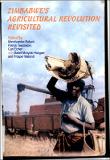| dc.contributor.author | Tagwireyi, Julia | |
| dc.coverage.spatial | Zimbabwe. | en |
| dc.date.accessioned | 2015-09-11T15:14:02Z | |
| dc.date.available | 2015-09-11T15:14:02Z | |
| dc.date.issued | 2006 | |
| dc.identifier.citation | Tagwireyi, J. (2006) The food and nutrition situation in Zimbabwe. In: Rukuni, M., Tawonezvi, P. and Eicher, C. (eds.) Zimbabwe's agricultural revolution revisited. UZ, Mt. Pleasant, Harare: UZ Publications, pp. 543-556. | en |
| dc.identifier.isbn | 0869241419 | en |
| dc.identifier.uri | https://opendocs.ids.ac.uk/opendocs/handle/20.500.12413/6986 | |
| dc.description | A book chapter on the food and nutritional status of Zimbabwe. | en |
| dc.description.abstract | The current levels of food and nutrition insecurity in Zimbabwe condemn a large section of the population to reduced intellectual and physical capacity and ill health, resulting in limited productivity and worsening poverty. The gains in nutrition during the 1980s have largely been eroded. This chapter discusses the food and nutrition situation in Zimbabwe by closely examining the patterns and impact on vulnerable populations. The nutrition situation is then related to the HIV and AIDS pandemic and poverty. Poverty makes HIV worse and AIDS makes poverty worse (Ray and Kureya, 2003). The increase in HIV infections and poverty has resulted in some doubts about the ability of the country to improve nutrition and food security.
The chapter then elaborates on the nutrition policy as well as the institutional set-up responsible for monitoring and addressing the nutrition problems. Emerging strategic partnerships are examined from the national (state and private) perspective and at the local level where the zunde ramambo concept has emerged as a crucial social safety-net for many vulnerable people. Social groups that have been identified as most prone to food shortages and hence malnutrition even in times of plenty are families working seasonally in existing and former large-scale commercial farming areas (Mehretu, chapter 5), some families in communal and resettlement areas, and low-income urban dwellers. Nutrition policy making was mooted with the aim of reducing the severity of the problem. The last two sections of the chapter examine the lessons learnt and the challenges that face the country in dealing with the problems of nutrition. | en |
| dc.language.iso | en | en |
| dc.publisher | University of Zimbabwe (UZ) Publications. | en |
| dc.rights.uri | http://creativecommons.org/licenses/by-nc-nd/3.0/ | en |
| dc.subject | Nutrition | en |
| dc.title | The food and nutrition situation in Zimbabwe | en |
| dc.type | Book chapter | en |
| dc.rights.holder | University of Zimbabwe (UZ) | en |


